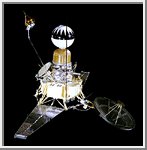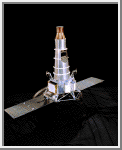











|
Courtesy of NASA's Space Science Data Center
The Ranger series was the first U.S. attempt to obtain close-up images of the lunar surface. The Ranger spacecraft were designed to fly straight down towards the Moon and send images back until the moment of impact. Ranger 7 impacted in mare terrain modified by crater rays. Ranger 8 also impacted in mare terrain, but this area contained a complex system of ridges. Ranger 9 impacted in a large crater in the lunar highlands.
Each Ranger spacecraft had 6 cameras on board. The cameras were fundamentally the same with differences in exposure times, fields of view, lenses, and scan rates. The camera system was divided into two channels, P (partial) and F (full). Each channel was self-contained with separate power supplies, timers, and transmitters. The F-channel had 2 cameras: the wide-angle A-camera and the narrow angle B-camera. The P-channel had four cameras: P1 and P2 (narrow angle) and P3 and P4 (wide angle). The final F-channel image was taken between 2.5 and 5 seconds before impact (altitude about 5 kilometers or 3 miles) and the last P-channel image 0.2 to 0.4 seconds before impact (altitude about 600 meters or 1,970 feet). The images provided better resolution than was available from Earth based views by a factor of 1000. These highly detailed images showed Apollo planners that finding a smooth landing site was not going to be easy.
| Views of Ranger |
|---|
 Rangers 3 - 5
Rangers 3 - 5
This image shows the Ranger spacecraft 3 through 5 that were used to
obtain close-up images of the moon. Ranger 3 was launched on January
26, 1962, but missed the moon. Ranger 4 was launched on April 23, 1962,
and became the first US spacecraft to impact on the moon. Ranger 5 was
launched on October 18, 1962. It was intended to impact but became a
fly-by because of a spacecraft failure.
 Ranger 7
Ranger 7
This is an image of the Ranger 7 spacecraft that was launched on July 28,
1964. It arrived at the Moon on July 31, 1964.
The spacecraft carried six television cameras. It sent back
high-resolution photographs of the lunar surface until its impact
in an area between Mare Nubium and Mare Cognitum.
Copyright © 1997-2000 by Calvin J. Hamilton. All rights reserved. Privacy Statement.